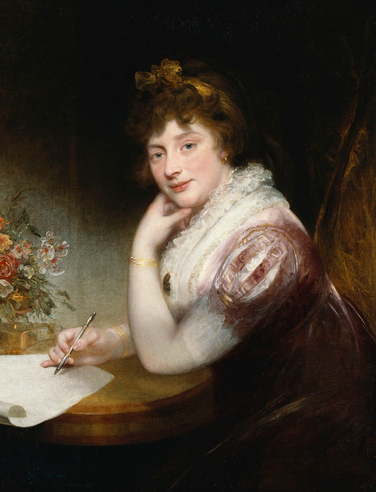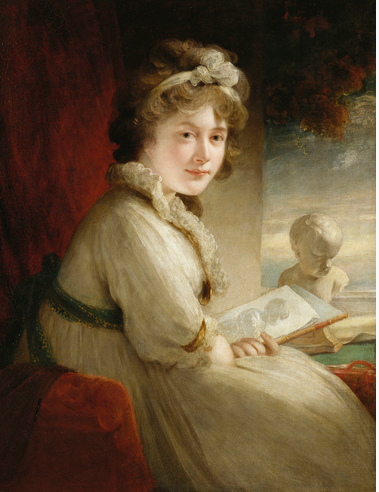Dating and Costume
Dating The Rice Portrait of Jane Austen
An eighteenth century painting
There is compelling evidence that Ozias Humphry was the artist responsible for the Rice Portrait. You can read more about this evidence in the Ozias Humphry Section and in the Photographic Evidence Section. Both his characteristic monogram and his signature have been detected on the portrait by independent experts. If it is accepted that Ozias Humphry is the artist then the painting cannot be dated after 1797 because Ozias Humphry lost his sight and did not paint after this date.
Eva Schwan, the conservator who worked on the painting for many months and detected Humphry’s monogram on the painting (see Ozias Humphry Section) is of no doubt that the painting is by Ozias Humphry and dates from the eighteenth century. OZIAS HUMPHRY (1742-1810), PORTRAIT OF JANE AUSTEN. This report follows a previous report from 2011, THE REVEALED MONOGRAM OH which explains about the Ozias Humphry monogram on the painting.
There are also several specific references to the date in primary documents reproduced in the Primary Evidence Section.
These are:
1) A letter from Fanny Caroline Lefroy to Mary Augusta Austen-Leigh dated 23 October 1883: ‘In 1789 the year it was painted she was a school girl in the Abbey School here.’
2) A letter from Henry Morland Austen to John Morland Rice dated 9 September 1884, after visiting Fanny Caroline Lefroy and reporting on his visit Henry Morland Austen wrote: ‘The date on your picture is (she thinks) 1788 or 9, making her not 14.’
3) Note written by Fanny Caroline Lefroy now in the possession of the Rice family in which she wrote: ‘In 1789 the date of the picture...’
You can view these letters in the Primary Evidence Section.
This date accords precisely with the other evidence we have that Ozias Humphry started the portrait in 1788 and completed it in 1789.
Card at NPG when the portrait was thought to be by Zoffany
The National Portrait Gallery previously dated the Rice Portrait (which at the time was attributed to Johan Zoffany) to 1790, as can be seen on the card which accompanied a print of the portrait taken from a phtograph taken by Emery Walker in 1910.
Costume
dating the dress
Doubts about the dating of the dress in the Rice Portrait were first raised by Austen scholar Robert Chapman in Jane Austen: Facts and Problems,(Clark Lectures, Trinity College Cambridge 1948). The timing was not a coincidence, the National Portrait Gallery (NPG) had just purchased the sketch of Jane Austen at auction which they now claim is the only authenticated picture of her. Chapman acknowledged he was no fashion expert but relied on the opinion of Charles Kingsley Adams of the NPG who had pronounced in 1941 that ‘The style of dress with narrow ribbon round high waist, and slightly puffed half sleeves is of the period c1805. In a search I have not found a similar dress on a dated portrait before 1803 when Jane was 28.’ We wonder where he searched - it was the height of World War Two and the NPG’s own collection had been moved into storage for safekeeping.
‘Self-celebrated experts in the history of costume have sworn blind (the perfect idiom for them) that the dress Jane wears could not have come from the needle of any English dressmaker until five years or so into the 19th century, by which time she was thirty – and in the portrait she is still a girl of between 15 and 20. This evidence is nonsense, proved so by other British portraitists of other British girls painted in the 1790’s’ (Brian Sewell, 2007)
The mistake of Chapman and others coming after him was to look at women’s fashion when he should have been looking at what girls were wearing. Up until the 1750s the dress of children largely echoed that of their parents, but in the second half of the eighteenth century a new idea of ‘childhood’ was emerging, which influenced dress styles for children. Anne Buck in Dress in Eighteenth Century England writes: ‘The period between the age of three or four until the age of thirteen or fourteen acquired an identity of its own and its own style of dress…From 1760s the frock and sash began to take over completely. The age for continuing to wear it, in best dress as well as everyday dress, gradually rose, until by the 1780s it was being worn by girls in their early teens in all dress.’ She further writes: The significance of these new forms of dress for children is not only that they changed children’s dress, but that adult changes were foreshadowed in them and were apparent here before clearly emerging in adult dress.The girls’ dress, with its freer bodice and sash was the style which by the end of the 1780s was becoming adult fashion, carrying the same freedom into women’s dress; once again women and girls were dressed alike.
This simple gown caused scandal in both France and England when it was worn publicly by Marie Antoinette, in this portrait painted by Elisabeth Vigée-Lebrun in 1783.
Nevertheless the chemise a la Reine, as the style became known, quickly became fashionable and by the year 1800 a woman in England was wearing clothing very similar to that her daughter may have worn ten or twenty years before.
Below is The Romps by William Redmore Bigg, painted in around 1795. A mezzotint of the painting was published in 1796.
The Romps by William Redmore Bigg. Bridgeman Images
Collectors Lillian and Ted Williams are experts in eighteenth century costume and parts of their extensive collection have been shown at the Metropolitan Museum in New York, the Musée de la Mode and the Louvre in Paris. They write: Having carefully examined the actual portrait, as opposed to its reproduction, we find several elements that clearly suggest an eighteenth century dating starting in the late 1780s. We ourselves have owned several eighteenth century gowns similar to the one pictured in the Rice Portrait. In the Rice Portrait, we note the fullness of the cut of the dress with substantial distribution of its fabric around the bodice rather than trained in the rear in the later Empire style. Furthermore, the gauze gathered around the neckline – which is not discernible in many photographic reproductions – is consistent with late eighteenth century garniture. Finally, the shoes and certainly the parasol with its fringe of cut green silk are consistent with the same period. As far as dating is concerned, the width of the ribbon at the bodice is of no consequence one way or the other in our view.
Many examples of similar dresses can be found, some of which are reproduced here.
Portrait of a Young Girl, John Russell, c 1780
“Pinkie”, Sir Thomas Lawrence, 1794
Portrait of an Unknown Girl, William Marshall Craig, 1794
Unknown Girl, Louis Ami Arlaud-Jurine, c1790
As Richard Walker, Regency expert at the National Portrait Gallery wrote in a letter to Deirdre Le Faye in 1993, "I think the costume experts have been over-confident and the dress she wears could be of the 1790's"
The dress feature which has caused most controversy is the puff sleeves. In 1975 Madeleine Ginsberg of the Department of Textiles at the Victoria and Albert Museum wrote: 'The earliest instance I can find of a puffed sleeve is in the portrait of Princess Augusta by Sir W Beechey 1802. Until 1800 sleeves are straight and tight.’ Of course Ms Ginsberg was working in the days pre-internet when researching examples would have been much more difficult. There is no justification for anyone making this statement today as costume expert Hilary Davidson did when she claimed she could not find a puffed sleeve dated pre-1800.
Here are some examples, starting with the one referred to by Madeleine Ginsberg: Princess Augusta by Sir W Beechey, part of the Royal Collection. (RCIN 403416)
It was painted in 1795-97, not 1802, along with portraits of George IV’s other five sisters. (William Beechey submitted his account for the six paintings to George IV in 1800.) With the exception of the eldest, Charlotte, all the princesses are wearing full puffed sleeves. For all but one of the princesses to be wearing puffed sleeves suggests they were in vogue by 1795.
Top Row (left to right): Charlotte, Augusta, Elizabeth
Bottom Row (left to right): Mary, Sophia, Amelia
There are examples of puffed sleeves earlier than this. For example there is the portrait of Anna Maria Hunt, painted by George Romney in 1792 and delivered to Anna Maria’s uncle on 20 June 1793. it is held by the National Trust, at Lanhydrock.
There is also this portrait of Lady Redesdale by John Hoppner dated 1790 and now held at the Joslyn Museum
Also of interest is Little Bo Peep by George Romney dated 1778 with a full sleeve.
Finally, here is a portrait of Lady Barbara Lucy Ashley-Cooper by Ozias Humphry. Signed and dated 1796. Exhibited by Humphry in 1797.
Note the full sleeves.
From these examples it is clear that any claim that puff sleeves are a feature of dresses only after the turn of the century is mistaken.
dating the hairstyle
‘The girl’s short, straight hair suggests a style fashionable in the early years of the French Revolution, while her parasol accords with an accessory popular from the 1780s. The influence of Thomas Gainborough (1727-1788) can be discerned in the girl’s emergence from a dark background which surrounds her head.‘
Marilyn Butler Jane Austen (VIP series)
Similar short hairstyles are easy to find. Here are some examples from the works of George Romney. Born in Dalton-in-Furness in 1732, Romney retired in ill-health to Kendal in 1799 where he died in 1802.
Firstly, a painting which many believe to be his masterpiece: The Gower Family: The Children of Granville,2nd Earl Gower, painted in 1777, which hangs at Abbot Hall Art Gallery in Kendal. The painting depict the five youngest children of Lord Gower. The eldest girl, with the tambourine is Anne, child of his second marriage, whilst the four younger children are by his third wife, Lady Susannah Stewart.
The Gower Family
The girl in the green dress on the left is Georgina Granville, born in April 1769, who later married William Elliot and became Countess of St Germans.
Detail showing Georgina’s hairstyle
Next, The Misses Cumberland, painted in 1773. The daughters of dramatist Richard Cumberland, Elizabeth (b.1759) is on the left and Sophia (b.1761) is on the right. They are holding a copy of their father's play The Fashionable Lover, published in 1772. Sophia therefore would be around 13 years old.
The Misses Cumberland
Detail showing Sophia’s hairstyle
Here are two more - The Vernon Children and Two Children in a Wooded Landscape.
The Vernon Children
Two Children in a Wooded Landscape
Detail showing hairstyle
















